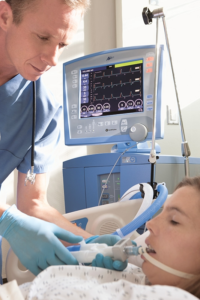This post may contain Amazon® product affiliate links. We may receive a commision if you make a purchase after clicking on one of these links but at no cost to you. Please visit Our Disclosure Page for more information. Thank you.
 BIPAP therapy can provide apnea sufferers with a restful night, without the worry of apnea episodes causing them to frequently awaken. This type of therapy will involve wearing a mask as the BIPAP machine delivers a steady flow of air into the lungs. The BIPAP settings are commonly based on the results of your sleep study and are set by a respiratory therapist.
BIPAP therapy can provide apnea sufferers with a restful night, without the worry of apnea episodes causing them to frequently awaken. This type of therapy will involve wearing a mask as the BIPAP machine delivers a steady flow of air into the lungs. The BIPAP settings are commonly based on the results of your sleep study and are set by a respiratory therapist.
How the Settings are Determined
Most models of this machine come with three different types of settings. The pressure delivered during inhalation will make it easier to breathe, while the exhaling pressure makes it easy to exhale. The settings are preset by the respiratory therapist, based on the prescription written by your physician or a sleep specialist.
The three modes of operation include spontaneous, timed and spontaneous and timed. The spontaneous setting will switch between exhale and inhale air pressures automatically, based on the machine sensing the switch in breathing. The timed setting will involve switching between the exhale and inhale pressure based on a programmed rate, in order to ensure the correct prescribed breaths per minute rate is being maintained. The spontaneous and timed setting will switch as it senses a change in your breathing. The timed function is in place as a failsafe, in order to ensure that you’re breathing correctly and not interrupted by a severe apnea episode.
 Speak with your physician in order to determine which settings your device should operate at.
Speak with your physician in order to determine which settings your device should operate at.
Generally, the BIPAP machines are used by patients who are unable to tolerate the same constant pressure of air that’s delivered by a CPAP device. This same pressure of air can make it difficult to exhale against, causing the user to frequently wake up throughout the night. As you can imagine, this type of issue can make apnea treatment ineffective.
A physician will usually prescribe a CPAP machine initially because it’s covered by health insurance. BIPAP machines usually aren’t, however, you can choose to rent a BIPAP device from a local medical supply store for a small fee each month. While it’s rare, some apnea sufferers will switch from a BIPAP to a CPAP machine, because the BIPAP devices can be pretty noisy.
How to Choose the Right Type of Apnea Mask
All apnea masks will work well with any type of PAP treatment device. Choosing the right type of mask can be the most important aspect of your apnea therapy. If the mask is uncomfortable, is too big or the wrong style, it can affect the quality of your treatment. When choosing a mask, make sure that you understand your options and try on a number of different styles before making a choice.
